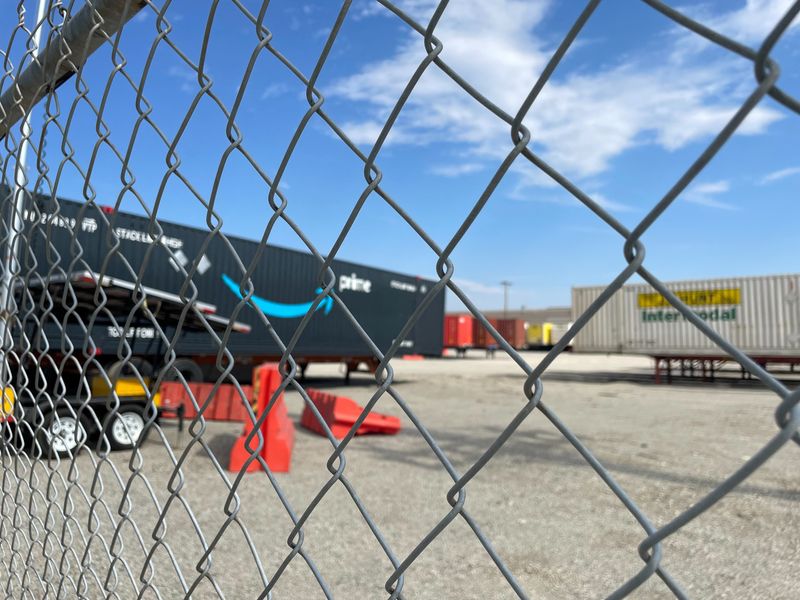America’s largest warehouse is running out of space. It’s about to get worse
Goods keep pouring in from across the Pacific, and for one of America’s busiest warehouse complexes, things are about to get worse.
Experts have warned that the US supply chain will be hit by the ‘whiplash effect’ if companies panic-order goods to keep shelves full and get caught up in a drop in demand as shipments arrive still from Asia.
In the largest warehouse and distribution market in the United States – stretching east from Los Angeles to the region known as the “Inland Empire” – that moment seems to have arrived.
“We’re feeling the sting of the whiplash,” said Alan Amling, a supply chain professor at the University of Tennessee.
The sprawl of Inland Empire warehouses centered in Riverside and San Bernardino counties has grown rapidly in recent years to keep up with growing demand and imported goods from Asia.
This burgeoning area, visible from space, anchors an industrial corridor encompassing 1.6 billion square feet of storage space that stretches from the busiest US seaport in Los Angeles to near the borders of Arizona and Nevada. This storage space is nearly 44 times larger than New York’s Central Park and 160 times larger than Tesla Inc’s new Gigafactory in Texas.
But a pullback in consumer spending now threatens to flood warehouses here and across the country with more goods than they can handle, compounding supply chain problems that have fueled inflation. Retailers who hoard unwanted goods are faced with the choice of paying more money to store them or reducing their profits by selling them at a discount.
Warehouse vacancies in the Inland Empire are among the lowest in the country, hitting a record 0.6% against a national average of 3.1%,
according to real estate services firm Cushman & Wakefield. [graphic: https://tmsnrt.rs/3oHaiXu]
GRAPHIC: No Place in the Empire
The market is poised to tighten even more as shoppers at Walmart, Best Buy and other retailers pull back from the spending sprees of the early COVID era. CASH IN ARREARS
As U.S. consumer spending remains above pre-pandemic levels, retailers and suppliers are alarmed by backlogs in categories that have fallen out of favor as consumers catch up on travel and battle the coronavirus. highest inflation in 40 years.
Last week, Walmart said soaring food and fuel prices were leaving lower-income customers with less money to spend on goods, and Best Buy said shoppers were cutting back on discretionary products like computers and televisions. Those warning signs followed Target Corp’s warning that it was struggling with too many TVs, kitchen appliances, furniture and clothes.
Suppliers – ranging from barbecue maker Weber Inc to Helen of Troy Ltd, a conglomerate of consumer brands that includes OXO cookware – have also warned of slowing demand and the urgent need to liquidate stocks.
As the US economy slowed, commodities continued to flow in at near record highs.
According to Descartes Datamyne, imports to U.S. container ports that handle retail cargo from China and other countries jumped more than 26% in the first half of 2022 from pre-pandemic levels. Christmas shipments and the reopening of major Chinese factory centers could further boost volumes.
Meanwhile, cargo continues to pour into the busiest port complex in the United States at Los Angeles/Long Beach. In the first half of this year, dockworkers handled about 550,000 more 40ft containers there than before the pandemic began, port data shows.
Christmas toys and winter holiday decorations landed on these docks in July, along with patio furniture for Walmart and stretchy pants, jeans and shoes for Target, said Steve Ferreira, CEO of Ocean Audit, who reviews shipping invoices.
Retailers ordered most of these goods months ago, and many are destined for the already packed warehouses of the Inland Empire.
“It’s a domino effect. Now the inventory is really going to pile up,” said Scott Weiss, vice president of Performance Team, a Maersk company with 22 warehouses in greater Los Angeles.
The demand for space in the Inland Empire is so intense that when 100,000 to 200,000 square feet of space become available, it “gets gobbled up in a second,” Weiss said.
SEARS AND PARKING
Investors have nearly 40 million square feet under construction in the Inland Empire — including Amazon.com Inc’s largest warehouse — and at least 38% are talked about, said Dain Fedora, vice president of research. for Southern California at Newmark, a real estate trading consulting firm.
As Amazon’s 4.1 million square foot facility rises on former dairy land in the Ontario city, the online retailer has shelved plans for construction in other parts of the country.
Amazon is the largest warehouse tenant in the Inland Empire and the country. Its decision to cut construction, coupled with rising interest rates and a slowing economy, is singling out other potential Inland Empire warehouse builders, real estate brokers told Reuters. and regional economists.
Meanwhile, the space rush continues.
Trucking company yards and spare land in the area have already been converted to makeshift container warehouses, so contractors are marketing vacant stores as standby warehouses of last resort.
Brad Wright is the CEO of Chunker, which bills itself as an AirBNB for warehouses, and works with everyone from state officials to owners of vacant big-box stores to find new places to store goods.
During a recent visit to the former Sears flagship store in the Inland Center mall in San Bernardino, Wright and a potential tenant strolled past collapsed ceiling tiles, sagging wall panels and idle escalators while trying to figure out how forklifts would navigate the abandoned space. Wright sees empty stores as an answer to relieving traffic jams.
“There are a lot of them seated and they are well located,” he said.
(Reporting by Lisa Baertlein in Los Angeles; Additional reporting by Siddharth Cavale in New York; Editing by Kevin Krolicki, Ben Klayman and Matthew Lewis)
By Lisa Baertlein


Comments are closed.